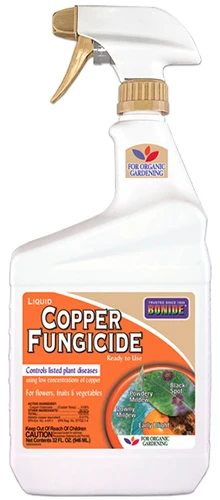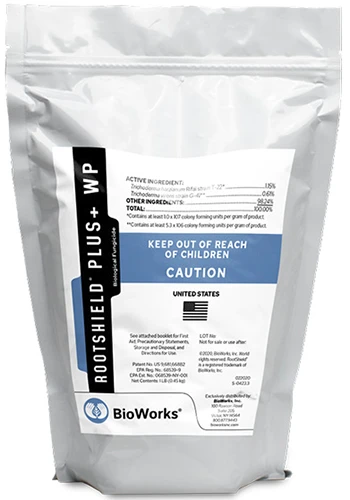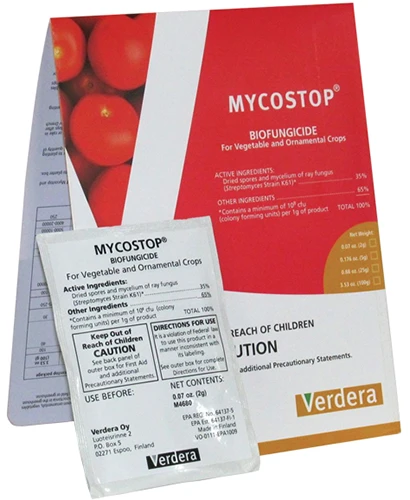A lot of people plant marigolds because they’re so easy to grow. They reseed themselves without becoming invasive, tolerate drought, and hardly seem bothered by pests or diseases.
But no plant is impervious to problems.

We link to vendors to help you find relevant products. If you buy from one of our links, we may earn a commission.
Marigolds can be attacked by many different disease pathogens, though it doesn’t happen too often. Typically, marigolds will be struck by disease only when they’re already stressed.
Crowding, overwatering, and poorly draining soil can all bring disease your way.
Sometimes, even despite our best efforts, easy-going plants like marigolds might be infected by pathogens like fungi or bacteria.
It’s frustrating, but diseases don’t have to spell disaster. Coming up, we’ll discuss the most common marigold diseases and how to deal with them. Here are the baddies to watch for:
Many diseases can be avoided by using smart gardening practices like crop rotation, careful watering, appropriate spacing, and cleaning your garden tools in between use.
But if all that fails, this guide will walk you through what to do.
1. Alternaria Leaf Spot
There are several diseases that can cause spots to form on the foliage of marigold plants.
Alternaria tagetica is a fungus that causes dark brown or black spots to form. These spots may or may not have a yellow, chlorotic ring around the margin.
The spots will eventually grow and merge until the entire leaf is dead, at which point, it might fall from the plant.
It’s not just the leaves that are impacted, though they’re usually the first to show symptoms. The flower petals might also develop spotting and will turn black and shrivel up.
The first step is to remove any symptomatic leaves or flowers.
Be extremely careful not to get any water on the leaves of the plant when irrigating, because this will just enable the pathogen to spread even further.
Then, spray every few weeks with a copper fungicide and a product that contains mancozeb.
Copper acts as a protectant, creating a protective barrier that fungal pathogens can’t penetrate. Mancozeb disrupts the life cycle of the fungi.
Together, they give you a fighting chance against alternaria. Spray them at the same time, allowing the first to dry before applying the next product.
Bonide Liquid Copper Fungicide
You can pick up a 32-ounce ready-to-use bottle, a 16- or 32-ounce ready-to-spray bottle for your hose, or a 16-ounce concentrate of Bonide Liquid Copper Fungicide at Arbico Organics.
In the future, appropriate spacing, careful weed control, and crop rotation every other year will help keep A. tagetica away from your marigolds.
2. Aster Yellows
Pretty much every plant in the Asteraceae family may be impacted by aster yellows.
It’s spread by aster leafhoppers (Macrosteles fascifrons), which carry the bacteria-like phytoplasma that causes the disease.
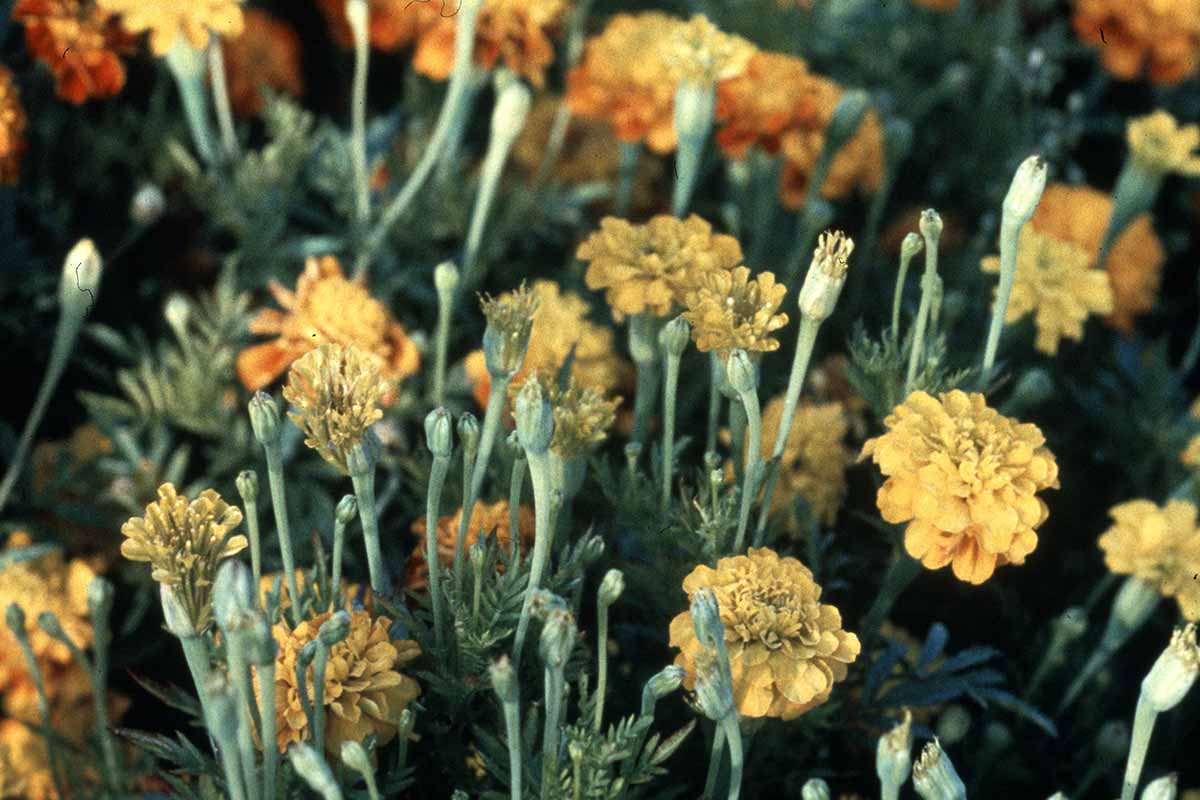
The symptoms can be a little all over the place. Typically, the flesh between the veins will turn yellow or white but the veins remain green.
The leaves might also twist and distort. Flowers will exhibit discoloration and deformed growth.
The flower head might develop leaf-like formations and growths that look like a second head coming out of the center of the blossom.
There’s nothing you can do to cure this disease. You’ll have to pull the plants and dispose of them.
Our guide to aster yellows can help you understand the issue and learn how to try to prevent it.
3. Bacterial Leaf Spot
Bacterial leaf spot sucks. Not because of the way it disfigures a plant, but because there’s no known cure. You’ll have to tear out the plant.
Because there are several diseases that may cause spots on the leaves, you’ll want to make sure you positively identify the symptoms you see as bacterial leaf spot, not alternaria or septoria.
Look for dark brown or black spots with purple margins.
Caused by the bacteria Pseudomonas syringae pv. tagetis, this pathogen only impacts marigolds.
But once it’s in your garden, you won’t get rid of it unless you pull all the marigolds you have and leave them out of your garden altogether for at least a year or two.
It spreads via water, so avoiding overhead watering can help to prevent it from spreading.
4. Botrytis Blight
Also known as gray mold, botrytis blight infects a wide range of plants. Marigolds are just a few among dozens of species, and unfortunately, this disease can be difficult to prevent and control.
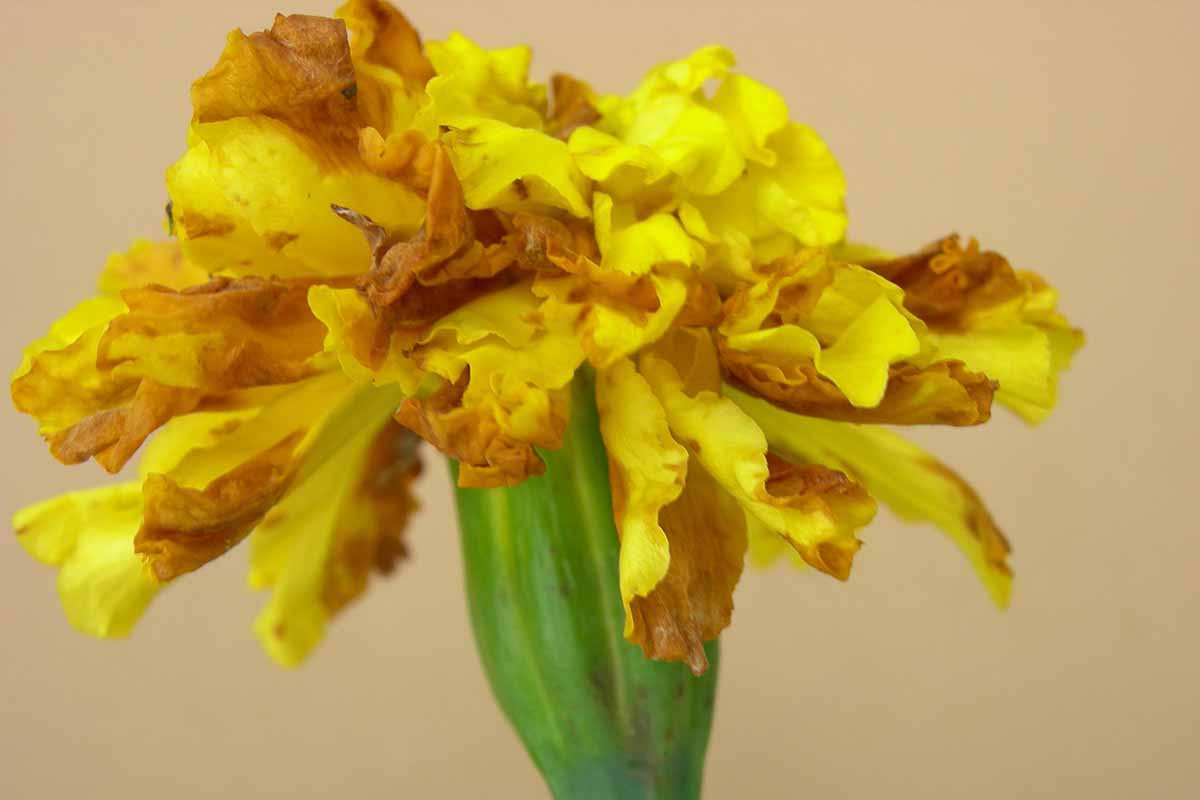
When the fungus Botrytis cinerea infects Tagetes species, it causes water-soaked lesions on the stems, leaves, and flowers.
The tissue inside these lesions will eventually die. Once they do, gray mold colonizes the dead tissue.
Botrytis can lay dormant in dead or living tissue, waiting for the ideal conditions with lots of moisture and temperatures between 65 and 75°F.
Prevention includes taking care only to water at the soil level and not on the plants themselves.
Straw mulch can help to keep water from splashing up onto plants, and appropriate spacing helps too. If you crowd your marigolds, it increases humidity and the time it takes for plants to dry out.
Typically, it’s best just to pull any infected plants or clip off the infected parts.
Unless you have an important reason to try and control the disease on your plants, such as a sentimental favorite marigold you’ve been cultivating via seed season after season, there’s no reason to use chemical treatments.
For that reason, we’re only going to discuss biological control.
When it comes to controlling an existing infection, this requires a multi-step approach. You need to address the spores as they wake up and start spreading in the spring and again in the fall as the weather starts to cool.
You also want to rotate the chemicals you use, because the fungi can quickly become resistant to whatever you use.
In the spring, use something that will attack the developing spores, such as a product containing the beneficial fungi Trichoderma spp. or Ulocladium oudemansii (strain U3).
Follow the manufacturer’s directions for application.
BotryStop WP contains U. oudemansii (strain U3) and was developed specifically to stop botrytis from growing and spreading.
It’s available in a 12- or 30-pound supply at Arbico Organics. Go in with your friends to split it.
The following year in the spring, alternate with something like RootShield® Plus WP, which contains T. harzianum strain T-22 and T. virens G-41.
It’s also available at Arbico Organics. Grab it in one-, three-, or 50-pound packages.
Then, just before the fall of the second year, switch to something different to tackle any spores that survived the first round of treatment.
Mycostop biofungicide contains the beneficial fungus Streptomyces strain K61. Apply it every few weeks to spray your plants in the late summer before fall symptoms appear.
Purchase five or 25 grams from Arbico Organics. A little goes a long way, and you’ll find this biofungicide is extremely useful for addressing lots of different fungal issues.
5. Fusarium Wilt
The soilborne fungus that causes Fusarium wilt, Fusarium oxysporum f. sp. callistephi, is a real jerk.
The pathogen can survive for years and years in the soil, and the available treatment doesn’t work well.
Symptoms include wilting even when plants receive the right amount of water, and the death of young seedlings as well as mature plants. You might even see dark streaks running up one half of the plant.
Some infected marigolds might not produce seeds, or if they do, seed production will be greatly reduced and these will often be sterile. Overall growth might be stunted, and the roots might turn black.
If you notice your plants have symptoms, your only good option is to pull and dispose of them. Don’t put them in your compost.
Then, plant any future marigolds in containers with fresh potting mix instead of in the garden beds, at least for the next five years or so.
6. Root Rot
Are you noticing stunted, wilting marigolds in the garden? Are leaves or flowers turning yellow or brown and dying? They might have root rot.
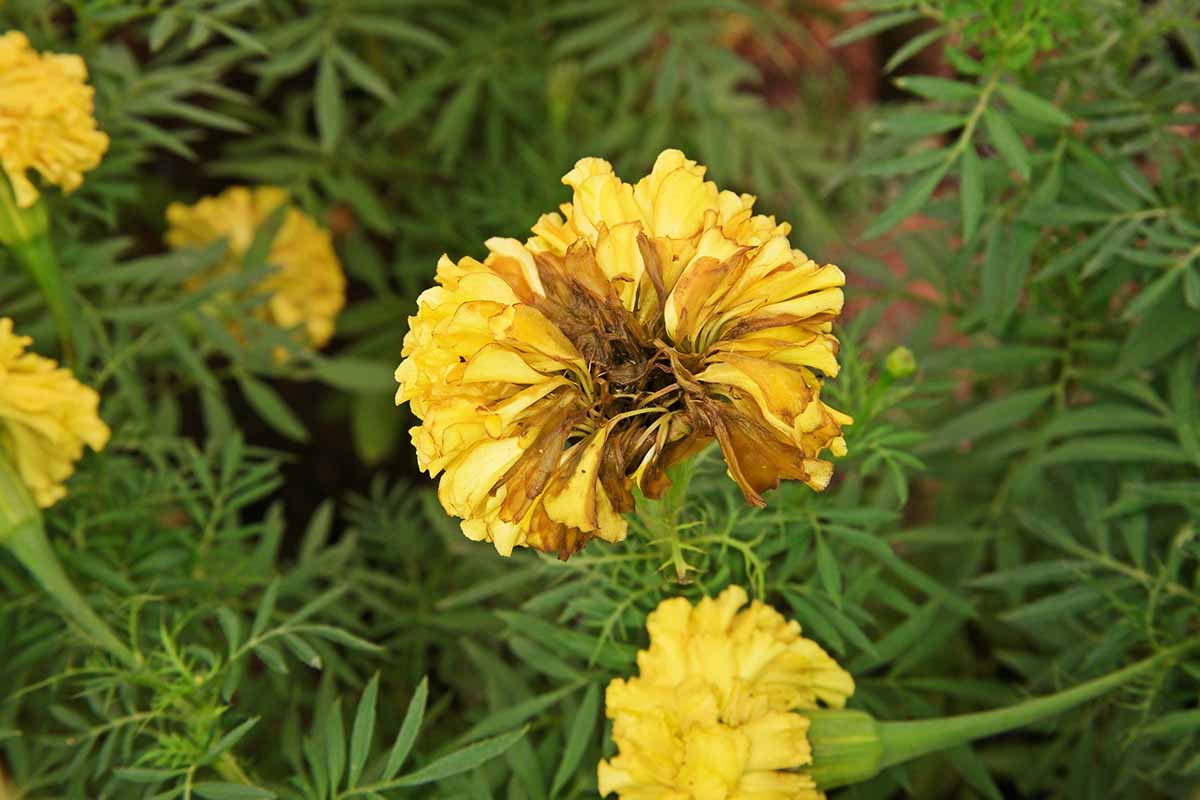
Caused by the fungus Rhizoctonia solani or Pythium oomycetes, it can also cause the stems to crack and the roots to turn brown and mushy as they rot away.
Only a lab test can tell you which pathogen is causing the problem, but it doesn’t matter much. Both thrive in 75 to 85°F temperatures and lots of moisture. They can be spread on tools, through water, or in contaminated soil.
That’s why good garden hygiene is crucial. Always sanitize your tools, whether you do that by washing them with soap and water, soaking them in a 1:9 solution of bleach and water, or both.
Ensuring that you plant in well-draining soil and avoiding overwatering will also help to prevent rot.
Sadly, if your plants are infected, the best option is to pull and dispose of them.
7. Septoria Leaf Spot
Another disease that results in spots on the leaves, this one is caused by the fungus Septoria tageticola.
It differs from Alternaria in that the spots are grayish-black and they lack the chlorotic halo. Inside the rotting circle, you’ll see fungal spores if you look closely.
Typically, the problem starts at the bottom of the plant and moves higher up as the disease progresses.
As with so many fungal pathogens, it thrives in temperatures above 60°F, especially when there’s also lots of moisture present, whether that’s from rain, high humidity, or irrigation.
Seeds might be infected and the disease will later appear on mature plants, or it can be transmitted in water or on yard tools. That’s why watering at the soil level, good air circulation, and appropriate spacing are vital.
To kill any pathogens on the seeds, soak them in 115°F water for 30 minutes. Plant straight away.
Cut off any infected leaves and treat the plants with a copper fungicide every three weeks for as long as symptoms are present.
8. Tomato Spotted Wilt Virus
This disease is spread by a virus that causes young leaves to turn bronze and older leaves to develop dark spots.
As the name suggests, it also causes the plants to wilt. Flowers might also die off.
Tomato spotted wilt virus is spread by Western flower thrips (Frankliniella occidentalis), so controlling them helps to keep your marigolds and many other plants safe.
Our guide to controlling thrips can help you with that.
But once it’s present, the only thing you can do is rip out and dispose of the infected plants.
It might be tempting to just leave them in the ground, but this virus attacks all kinds of species, including nightshades, legumes, and cucurbits.
If you’re growing marigolds as a companion plant to try and control pests, it won’t do much good if it ruins your tomato harvest.
9. Verticillium Wilt
This disease is caused by the same pathogen that infects box elder trees and watermelons – the fungus Verticillium dahliae. In other words, it’s a problem for a huge range of plants.
In marigolds, it causes part of the plant to wilt and die, with yellow and brown leaves. As the disease spreads, the entire plant will die. While it can take years to kill a large plant, a marigold might die in a few months.
The disease attacks the roots first, killing them. That’s what in turn causes the upper parts of the plant to die.
The fungi can live in the soil for a long time, and it can live on fallen plant debris. Crop rotation, solarizing soil, and cleaning up the garden in the fall are all effective in at least slowing its spread.
Remember that Mycostop biofungicide we mentioned above? It’s an effective treatment for vert. Just be sure to follow the manufacturer’s directions closely.
Make Your Marigolds Merry
Don’t scroll through this list and conclude that marigolds just aren’t worth the trouble.
True, there are many diseases that can attack marigolds, but they rarely do. Especially if you use smart garden practices like crop rotation, appropriate spacing, and watering at the soil level.
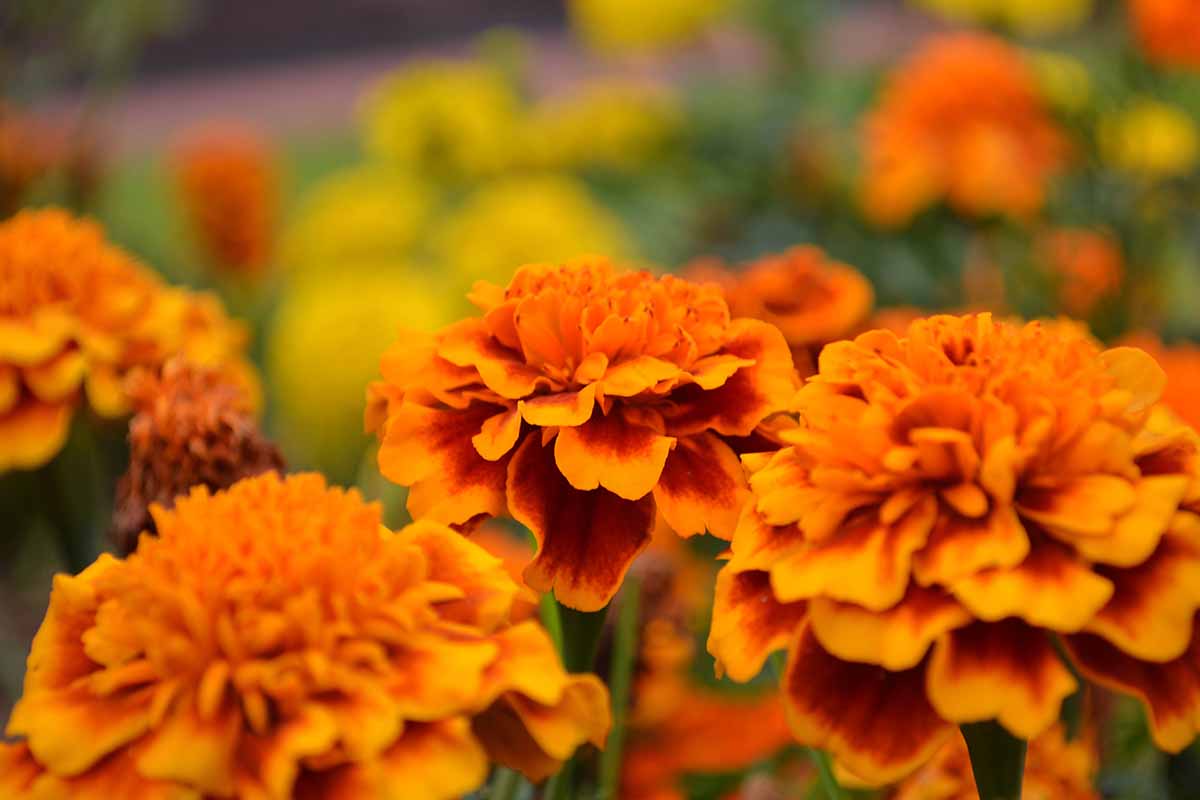
If you grow your plants in potting soil in a container, you reduce the chances of contracting any of these diseases even more. And marigolds are so cute in containers!
Which disease are you dealing with? What symptoms or challenges are you facing? Let us know in the comments if you’re having trouble, and we’ll try to help.
If you’re ready to continue your marigold-growing adventures, we have lots of guides to help you on your way:
